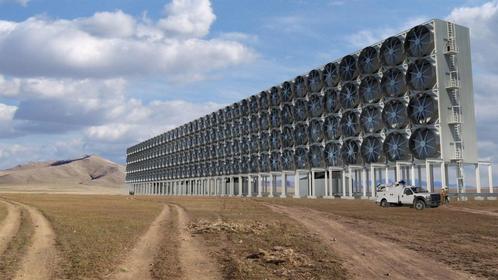A Calgary-based company, Carbon Engineering is promising to take carbon dioxide of thin air and turn it into a resource. Ambitious as it may sound, carbon capture is a rapidly maturing technology, and Carbon Engineering is taking a demonstration facility in Squamish, BC into operation during 2015. The picture below shows what an array of air contactors may look like if the design is scale up to a commercial size.

The company still has a long way to go before the technology becomes commercially viable. There are engineering challenges, but more importantly, big economic challenges. Similar to Inventys, a BC-based company I discussed in my August 20, 2014 blog, getting from a smart innovation to a commerically-successful technology is a difficult path.
The basic idea of how to capture carbon dioxide from thin air is not new. However, making it efficient is another matter. Air contactors propel large amounts of air through a type of scrubber where a capture solution of potassium hydroxide flows down across contact sheets that take up to 80% of the carbon dioxide into a water and potassium carbonate solution. This carbonate solution is then fed into a pellet reactor that regenerates the solution by bringing it into contact with calcium hydroxide. This process recovers potassium hydroxide that is reused as a capture solution, as well as calcium carbonate that binds the carbon dioxide. The calcium carbonate is separated from the capture solution and is brought to a fluid-bed calciner that operates at 900°C and decomposes the calcium carbonate into pure carbon dioxide and calcium oxide. The carbon dioxide is captured, and the calcium oxide is brought into contact with water and reacts to generate calcium hydroxide. Essentially, there are two separate chemical cycles at work.
The critical input into the process is energy in the form of heat. The demonstration plant will burn natural gas in a pure oxygen environment to generate the required heat and produces only carbon dioxide, which is also captured. This process is either relying on the oxyfuel method, a process to provide pure oxygen from air through cryogenic separation, or by using electrolysis to separate oxygen out of water using electricity.
The economic feasibility of the technology hinges on two cost factors: the fixed cost of building the air contactor and the regeneration system, and the variable cost of energy for powering the system and providing pure oxygen. Eventually, power can also be provided from clean energy rather than natural gas. Ideally, carbon capture plants can be placed in places where clean energy is readily available. But this opens up another challenge: what to do with the captured carbon dioxide.
If the ultimate goal is carbon sequestration, a carbon capture plant needs to be near a suitable sequestration plant. And this may be in locations where renewable energy may or may not be readily available. Alternatively, carbon dioxide can be turned into fuel. This is indeed what Carbon Engineering has in mind. Take water and carbon dioxide and clean energy, and get carbon fuel (e-diesel) in return.
Start with clean energy and water. Use electrolysis to separate water into hydrogen and oxygen, which is particularly efficient when applied to super-heated steam. The hydrogen is then combined with carbon dioxide in a conversion reactor to produce more hydrogen, water, and carbon monoxide. Lastly, using the Fischer-Tropsch process, the syngas made up of hydrogen and carbon monoxide is combined under high heat and pressure to generate what is known as blue crude, a synthetic fuel that can be refined into e-diesel. A demonstration plant was built by clean-tech company SunFire and the car manufacturer Audi in the German city of Dresden.
Capturing carbon dioxide out of thin air thus hinges on one critical element: plentiful and cheap non-fossil energy. As solar power and wind power become more readily available, making fuel out of water and thin air may also help solve the intermittency problems of renewable energy sources. However, the Achilles Heel of all of these impressive innnovations is cost. Can these technologies become commercialy viable? As of today, they are not. But a decade hence, perhaps?
Meanwhile, if you are passing through Squamish, BC on the Sea-to-Sky Highway, take a quick detour and drive by a modest industrial building on 37322 Galbraith Avenue in the city's harbour area. The air around there will have less carbon dioxide than elsewhere.
Founded by Harvard University professor David Keith in 2009 and funded by Microsoft Founder Bill Gates, Carbon Engineering is one of the eleven finalist in the $25 million Virgin Earth Challenge, offered by Richard Branson and former U.S. Vice President Al Gore.
Further readings and sources:
- Anne Eisenberg: Pulling Carbon Dioxide Out of Thin Air, The New York Times, January 5, 2013.
- Marianne Lavelle: Out of Thin Air: The Quest to Capture Carbon Dioxide, National Geographic News, August 12, 2011.
- Nick Eagland: Squamish site will debut device that pulls carbon dioxide directly out of the air, The Province, August 12, 2015. Calgary company ready to capture carbon in Squamish 'pilot plant', CBC News, October 13, 2015.
- The big question mark over gasoline from air, New Scientist, 22 October 2012.
- Daniel Cressey: Commercial boost for firms that suck carbon from air—Two companies expand their extraction plants and line up customers, Nature, 14 October 2015.
- K.S. Lackner: Capture of carbon dioxide from ambient air, European Physical Journal Special Topics 176(1), September 2009, pp. 93-106. See also here
- BC Ministry of Energy And Mines: Fuel from thin air! Province supporting synthetic fuels project in Squamish, Press Release, October 9, 2015.
Related firms:
- Climeworks, Zurich, Switzerland.
![[Sauder School of Business]](logo-ubc-sauder-2016.png)
![[The University of British Columbia]](logo-ubc-2016.png)